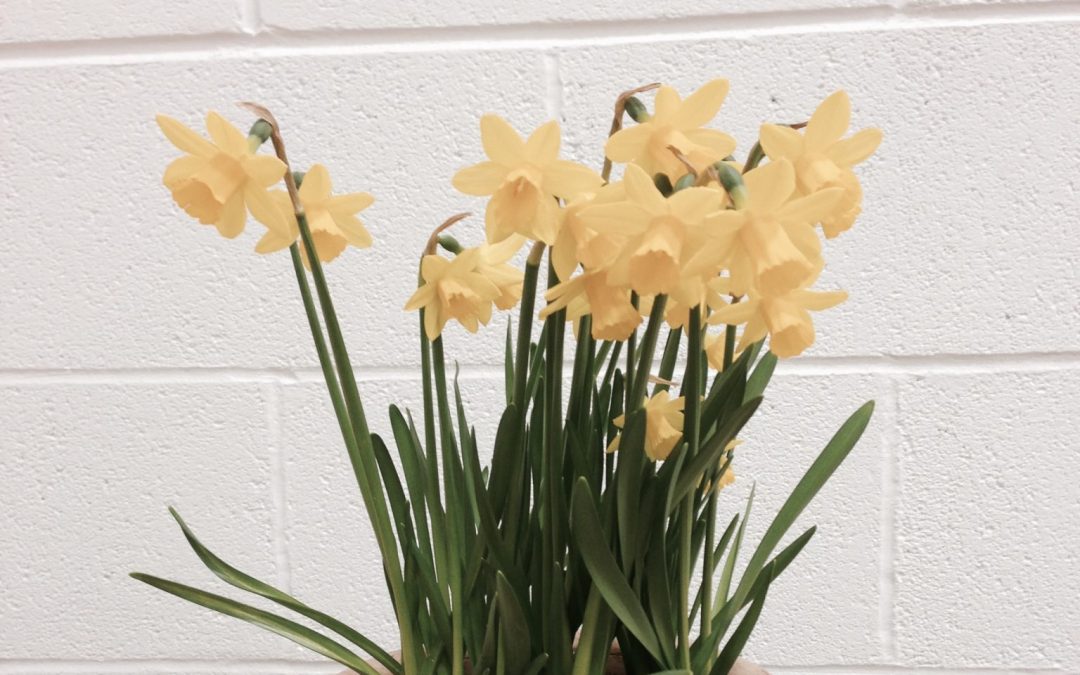Daffodils can be seen everywhere in gardens and green spaces in spring. This is a blog dedicated to this bright, cheerful, romantic, and mythical flower. Whether you call them daffodils, narcissus, Lent lilies, dafadowndillies, or Easter bells, or one of your own special names, the daffodil is a plant that for very many people signifies friendship, eternal life, new beginnings and happiness. Blooming in spring in gardens and green spaces everywhere. Recognised even by young children; there can be no mistaking this beautiful bright perennial plant.
The daffodil has a long history, and features in myth, legend, literature and poetry. Before setting out some of these romantic tales of old, it is best if one of the daffodil’s more notable characteristics, but perhaps conversely less well known, is set out first – namely, its toxicity.
In ancient times the plant was used to treat all manner of ailments from catarrh, to joint pain, from baldness, to tumours and even cancer. However, the bulb, stem and leaf of the plant are all actually poisonous to humans and animals (and even some other plants), and all parts of the plant have a repellant taste which acts as the plant’s inbuilt defence mechanism.
Due to this repellant taste, it is therefore unlikely for a human to accidentally eat enough of the plant to cause death. Having said that, in 2009 a number of school children fell ill when a daffodil bulb was mistaken for an onion and added to a pot of soup during a cookery class. Mistaking the daffodil bulb for an onion has also been recorded in other more historical poisoning incidents. It’s also possible for some people to develop a rash or itch when handling large amounts of the plant, including just the bulbs, so extra care should be taken, especially if there is a risk of the plant coming into contact with any cuts, grazes or wounds on the hands. Wearing gloves and/or good hand hygiene during and after handling is always advisable.
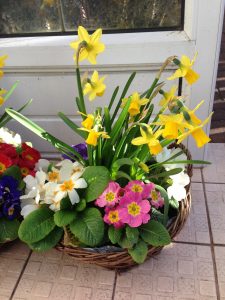
Please do not let a daffodil’s toxicity deter or scare you. There are many plants in our gardens that are poisonous if eaten. Neither humans nor animals are likely on purpose to consume enough daffodils to be deadly, and simple measures such as hand washing after handling is all that is required.
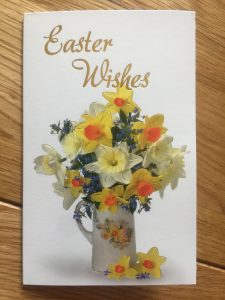
Despite its poisonous characteristics the daffodil has understandably been loved by many through the ages for its beauty, resilience and ability to renew and regenerate. A number of cancer charities across the world have adopted the daffodil as their fundraising flower. The daffodil is also the national flower of Wales, and is associated with St David’s Day on the 1st of March.
The daffodil is certainly a popular flower appearing in gardens and green spaces all over the UK in spring time, and as a result is associated with Easter. Spring, being a time of new beginnings, has also resulted in the flower being associated with good fortune, luck and prosperity. The distinct wide open flower heads are also said by some to represent beautiful wide open eyes.
The daffodil is often referred to by the plant’s botanical name ‘narcissus’, which many associate with the ancient Greek-Roman myth of the young man Narcissus who was lured to a stream by Nemisis (the Goddess of revenge) for his treatment of Echo the mountain nymph. Echo saw Narcissus, who was a handsome hunter, walking through a wooded glade and immediately fell in love with him, but Narcissus was said to be so in love with himself that he scorned Echo’s affections. Nemisis was angered by this and tuned the young man’s vanity against him. Narcissus was so fixated by his reflection in the stream that he was unable to move. Some versions of the story say after a very long time he just melted away into the yellow and white narcissus flowers. Others say the Gods eventually felt sorry for him and turned him into the flowers, and that even the flowers still bowed their heads gazing into the water at their reflection. Another ancient Greek myth surrounding the daffodil plant is that Persephone (a Goddess, and daughter of Zeus) was said to have been abducted into the underworld by Hades while picking dafodils. She became the wife of Hades and Queen of the Underworld. Persephone is said to leave the Underworld each spring, symbolised as the daffodils begin to reappear every year, and as she returns to the Underworld the flowers begin to die back.
A notable reference to daffodils in literature is in The Winter’s Tale by Shakespeare:
“Daffodils, that come before the swallow dares, and take the winds of March with beauty”.
And, one of the most famous daffodil references is in the poem, ‘I wondered lonely as a cloud’, by William Wordsworth. The opening verse is as follows:
I wandered lonely as a cloud
That floats on high o’er vales and hills,
When all at once I saw a crowd,
A host, of golden daffodils;
Beside the lake, beneath the trees,
Fluttering and dancing in the breeze.
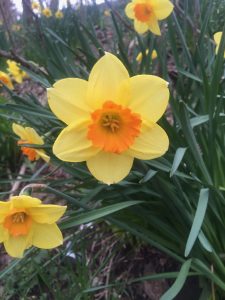
Wordsworth’s inspiration for the poem may have come from taking a walk with his sister, Dorothy, a couple of years earlier. Dorothy kept a journal, and on the 15th of April 1802 she wrote the following record of their walk together near a lake shore in the Lake District:
“I never saw daffodils so beautiful they grew among mossy stones about and about them, some rested their heads upon these stones as on a pillow for weariness and the rest tossed and reeled and danced and seemed as if they verily laughed with the wind that blew upon them over the lake, they looked so gay ever dancing ever changing. The wind blew directly over the lake to them. There was here and there a little knot and a few stragglers a few yards higher up but they were so few as not to disturb the simplicity and unity and life of that one busy highway”.
The plant has become very popular along roadsides, and when I see the long drifts of the yellow trumpet flowers in spring I think of Wordsworth’s poem, his love of daffodils, and of Dorothy’s reference to a ‘busy highway’ of daffodils.
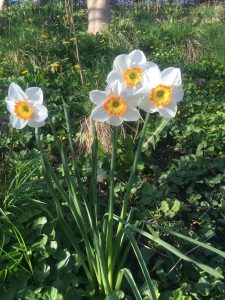
There may be a few who might find the daffodil a common plant not worthy of a lot of attention or affection, regardless of its relationship with myth, literature and poetry. Perhaps those few would benefit from revisiting the daffodil now and again. The daffodil’s beauty and resilience has been admired since ancient times, and it is still loved and admired by so many, young and old, even to this day. Daffodils now come in so many colours, varieties, shapes and sizes. There is bound to be a daffodil to capture your heart. Daffodils can be grown in large drifts in the biggest of gardens, in pots on doorsteps, or in tiny pots on a balcony or even on a window ledge in a small flat. Daffodils will be here when we are all gone. May they bring pleasure and put smiles on the faces of future generations in perpetuity.
For me, the daffodil’s history, timing, romanticism, beauty and resiliance is what makes me enjoy this plant so much.
What about you? Do you enjoy daffodils? We’d love to read your view in the comments section below.
I hope this blog post encourages you to introduce some daffodil varieties in your garden.
Michael
Mr & Mrs Gardens Limited

